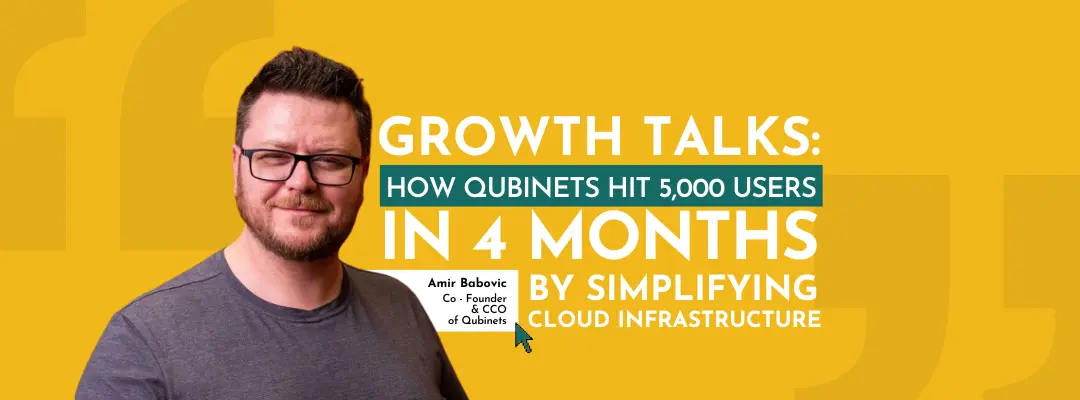Welcome to another Growth Talk!
Today, we’re talking with Amir, the CCO and co-founder of Qubinets and co-founder of Wespa Spaces. With 15 years of experience building businesses, products, and teams for some of Europe’s top tech companies, Amir has a lot to share. Recently, he started two new projects, one focused on helping startups to grow and another one focused on AI and Big Data, combining his love for technology and growth.
One of his projects, Wespa Spaces, provides much-needed support for startups in Croatia. The other, Qubinets, helps companies to deploy and manage their data Infrastructure through an intuitive UI. Since its launch less than a year ago, Qubinets has already hit impressive milestones: over 5,000+ registered users, 1,300 returning users, and 1,900 cloud projects created on the platform.
Keep reading to learn more about his journey and how he’s making it happen!
Let’s start:
What is the backstory of Qubinets? How did you get from an idea to a business?
Qubinets is spin-off of internal platform to automate containerized apps provisioning created by ex-Dataflux, now Dataverse. That company worked on major infrastructure monitoring project for Deutsche Telekom,which led to first versions of managed Open Source tooling, so that provisioning could be sped up for fast prototyping and building the application backends without need for much of the DevOps resources.
What problem were you trying to solve when you founded Qubinets, and how has that evolved?
We are solving an increasing need for expensive know-how on cloud and containers when building the cloud applications. We have seen developers wasting weeks either learning once-off skills or waiting for DevOps to setup and provision cloud assets before they can deploy and test their code, especially when working with large data sets.
Looking at your company content, we notice that you’re talking a lot about how easy it is to build and deploy products like AI agents. Apart from the AI agent case, are there any other use cases where Qubinets can fit nicely?
Qubinets’ cloud infrastructure can support a wide range of digital projects, from websites and data analytics platforms to stateful applications using the cloud as a backend. The new version of Qubinets makes it easier to deploy your own code as well as existing Open Source code. While we focus primarily on AI use cases right now, our approach is to target high-demand verticals. This means we’re currently prioritizing specific connectors and best practices for a limited set of use cases during the platform’s early stages. However, in the future, we aim to support a much broader range of use cases.s not mean we won’t be able to cover much broader set of Use cases in the future.
Qubinets recently hit 5,000 users, and 1,900 cloud projects were created in just a few months! What do you think drove this early success? Can you share some growth strategies?
Its 8000 accounts and 2600 clouds now – however I can only say its holistic approach to User experience when interacting with our brand. We try many different things and measure outcomes. Having ability to work with data easily and understanding its impact helps immensely. Our product in itself is first client for Qubinets, having ability to use AI, data analytics, automation and based on collaboration and lots of “trial and error” attempts – we believe we “engineered” this successes in a same way we can help others. When we take care of data infrastructure, our team can focus on creativity and doing things knowing every move is positive in a sense of data we collect – even if it’s not right or has negative outcome, we still learn and improve from it.
Growing a startup is challenging. Is there a mistake you made early on that you’d advise other founders to avoid?
Focusing on product too much has been detrimental, even by being aware of this pitfall – we developed the idea which was complex to implement and very ambitious in its functionality. This made it hard to spend and focus on other aspects of our operations and company. We are lucky we did deliver and its working, but it was do or die moment I would rather avoid. Its great achievement now, but it was also big risk.
What’s been the biggest learning moment for you as a founder?
Talking to VC and learning that startup should not be too ambitious was kind of surprising. We had feedbacks that project looks “too good to be true” – even with amazing engagement numbers we had comments “its great if its true”, so I have sensed that less ambitious, lower valuated projects, that have higher chance to “not fail” – might have better stickiness with investors.
What’s next for Qubinets? Any exciting projects or features in the pipeline you can share?
We are soon releasing research, result of cooperation with Ernst&Young that aims to provide companies with self-assessment on Ai readiness, we are working on some strategic moves with infrastructure partners and hope we will be able to reach the 10th paying client by mid of Q4. There’s some other exciting talks with large industry players, but it would be counterproductive to tease things that are still conceptual.
What advice would you give to fellow founders looking to grow their companies in the AI space?
I would recommend making a short path to clients, talk about their needs and focus on product following that. I know we have developed some things that won’t be used in the next 6 months or so – products should never have time spent on aspects that won’t create short-term value in one way or another. AI is emerging market, so I would recommend to hold tight as many winds and changes are coming, those that are ready for anything will come out as winners.


